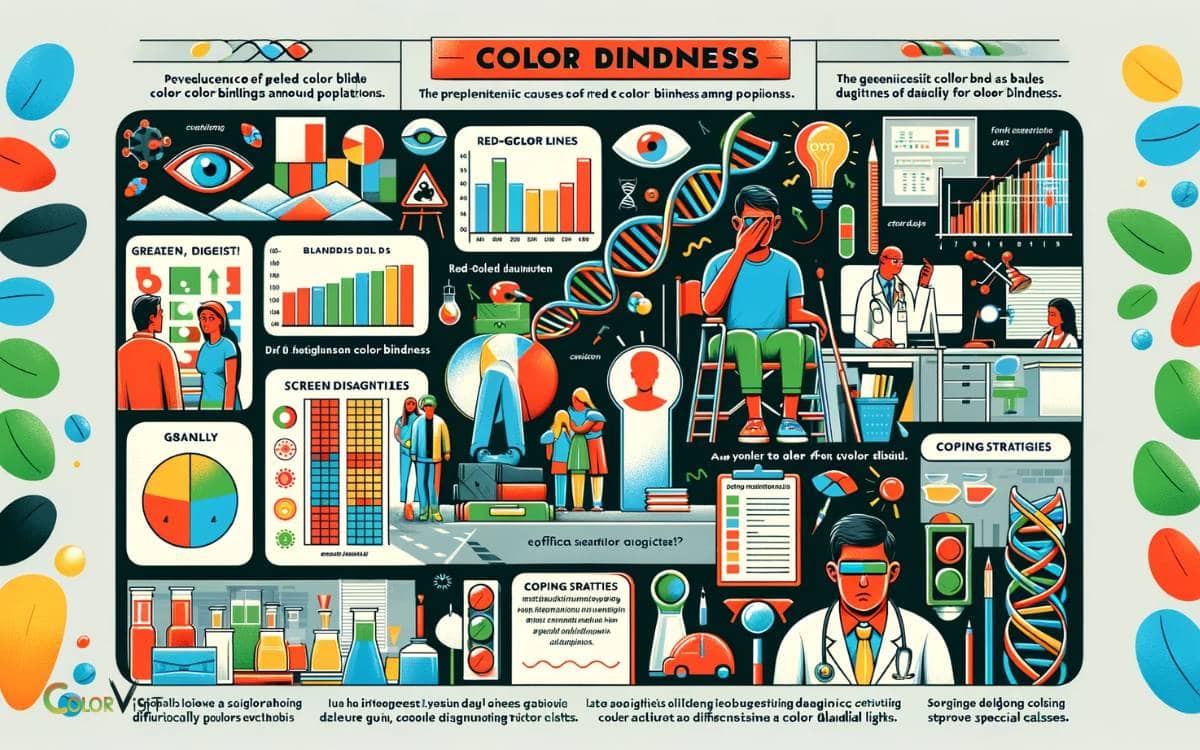How Common Is Red Green Color Blindness? Vision!
Red-green color blindness is a common form of color vision deficiency impacting a significant global population. It is a condition characterized by the inability to distinguish between certain shades of red and green.
Red-green color blindness is primarily a genetic condition, often passed down from parents to their offspring.
It occurs due to the presence of defective color detecting cells in the retina of the eyes. For example, a person with this condition might confuse red and green traffic lights.
This condition can be categorized into two types:
Despite its prevalence, red-green color blindness doesn’t usually interfere with normal daily activities. Innovative solutions like color-correcting glasses can help those affected lead a normal life.
Key Takeaway
Prevalence of Red-Green Color Blindness
Red-green color blindness affects approximately 1 in 12 men and 1 in 200 women worldwide.
This condition is the most common form of color vision deficiency, primarily caused by genetic mutations on the X chromosome.
- Individuals with red-green color blindness have difficulty perceiving differences between red and green hues, leading to visual impairment in distinguishing certain colors.
- The prevalence of this condition varies among different populations and ethnic groups.
- It significantly impacts color perception, making it challenging for affected individuals to engage in activities that require accurate color recognition, such as identifying traffic lights or interpreting color-coded information.
Understanding the prevalence of red-green color blindness is crucial for developing innovative solutions and technologies to assist individuals with this visual impairment in daily tasks, ultimately enhancing their quality of life.
Genetic Causes of Color Blindness
The genetic causes of color blindness are primarily attributed to mutations on the X chromosome, resulting in the most prevalent form of color vision deficiency globally.
- Inheritance patterns play a crucial role in the transmission of color blindness.
- Since the gene responsible for color vision deficiency is located on the X chromosome, the inheritance pattern is different for males (XY) and females (XX).
- Males are more likely to inherit color blindness from their mothers, as they only have one X chromosome.
In contrast, females need to inherit the mutation on both X chromosomes to be color blind. Gene mutations affecting the photopigments in cone cells lead to color blindness.
The most common types of color blindness are protanomaly, deuteranomaly, and protanopia, each caused by specific gene mutations.
| Type of Color Blindness | Gene Mutation Responsible |
|---|---|
| Protanomaly | OPN1MW gene mutation |
| Deuteranomaly | OPN1MW gene mutation |
| Protanopia | OPN1MW gene mutation |
| Deuteranopia | OPN1MW gene mutation |
| Tritanopia | OPN1SW gene mutation |
Understanding the genetic basis of color blindness is crucial for developing potential treatments and interventions.
This knowledge can also aid in genetic counseling and early detection of color vision deficiencies.
Impact on Daily Activities
Individuals with red-green color blindness experience challenges in accurately perceiving and differentiating specific colors in various daily activities.
- This condition can lead to color confusion and visual challenges, impacting tasks such as interpreting traffic lights, identifying ripe fruits, and distinguishing between color-coded information.
- Color confusion may affect their ability to work in professions like graphic design, electrical wiring, and certain types of manufacturing, where differentiating colors is crucial.
- Additionally, activities such as selecting appropriate clothing or engaging in hobbies like painting can be affected.
- As a result, individuals with red-green color blindness may face limitations in both personal and professional spheres due to these visual challenges.
- Understanding the impact of color blindness on daily activities is crucial for developing strategies to mitigate its effects and enhance the quality of life for those affected.
Screening and Diagnosis Methods
Challenges in accurately perceiving and differentiating specific colors in various daily activities necessitate effective screening and diagnosis methods for red-green color blindness.
- Color vision tests play a crucial role in identifying color vision deficiencies.
- Ishihara plates, which consist of colored dots forming numbers or patterns, are commonly used for this purpose.
- Additionally, the Farnsworth-Munsell 100 hue test is utilized to measure color discrimination and identify the type and severity of color vision deficiencies.
- Another valuable tool is the anomaloscope, which assesses color matching ability.
- Furthermore, color blindness simulation through specialized software and applications allows healthcare professionals to better understand and explain the visual experiences of individuals with color vision deficiencies.
These methods enable accurate diagnosis and provide valuable insights for developing strategies to support those with red-green color blindness.
Coping Strategies for Color Blind Individuals
Effectively coping with color blindness requires individuals to adapt to their visual limitations in various aspects of daily life.
In the workplace, color blind individuals can benefit from specific accommodations to ensure they can perform their tasks effectively.
- These may include using color-blind friendly software, labeling colors with text or symbols, and providing alternative communication methods for color-coded information.
- Additionally, color vision tests can help individuals understand the extent of their color blindness and develop coping strategies accordingly.
- Regular eye check-ups and awareness of their condition can also assist in managing color blindness.
By utilizing these coping strategies, color blind individuals can navigate daily challenges with greater ease and continue to excel in their personal and professional lives.
| Coping Strategies | Description | Benefits |
|---|---|---|
| Workplace accommodations | Adaptations in the work environment | Improved task performance |
| Color vision tests | Assessing color perception | Understanding visual limitations |
| Regular eye check-ups | Monitoring vision health | Early intervention for changes |
Conclusion
Red-green color blindness is a common genetic condition that affects a significant portion of the population. It can impact daily activities and requires proper screening and diagnosis methods for identification.
Coping strategies are essential for individuals with color blindness to navigate their surroundings effectively.
As we consider the prevalence and impact of this condition, we must ask ourselves.






